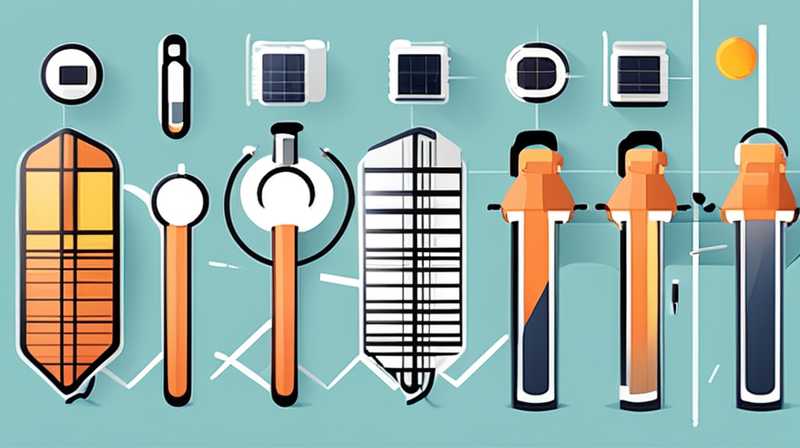
To successfully undertake the task of repairing solar integrated lights, several critical steps and considerations need to be addressed to ensure functionality is restored. 1. Identify the problem, 2. Examine the solar panel, 3. Check the rechargeable battery, 4. Inspect the LED lights. Among these, in-depth analysis of the solar panel plays a crucial role, as it directly affects how well the lights charge and operate.
1. IDENTIFY THE PROBLEM
When it comes to diagnosing issues with solar integrated lights, a methodical approach is essential. Observing the behavior of the lights can provide significant clues as to what might be going wrong. Common indicators of problems include lights not turning on, flickering, or remaining dim despite sufficient sunlight. Each of these symptoms can point to specific components that may require attention.
For instance, if the lights are not illuminating at all, it may suggest a failure in the solar panel’s ability to convert sunlight into energy. It’s important to systematically rule out each component, starting with external factors such as positioning and exposure to sunlight. Once the potential causes have been visually assessed, the next step is to take a closer look at the internal components.
2. EXAMINE THE SOLAR PANEL
The solar panel is the heart of any solar integrated light system. A thorough examination of this component is crucial. If the panel is dirty or covered with debris, sunlight may be obstructed, preventing effective charging. Regular cleaning using a soft cloth and mild soap can help maintain optimal performance. Additionally, positioning the lights at an angle that maximizes sunlight exposure can greatly enhance charging efficiency.
Moreover, inspect the solar panel for signs of physical damage such as cracks or corrosion. Such issues can significantly impair the panel’s functionality, leading to inefficient energy conversion. If damage is detected, replacing the solar panel is often the most feasible solution, ensuring a long-term return to functionality.
3. CHECK THE RECHARGEABLE BATTERY
The rechargeable battery serves as the storage system for energy collected by the solar panel. Numerous types of batteries are used in solar lights, including Nickel-Cadmium (NiCd), Nickel-Metal Hydride (NiMH), and Lithium-ion. Understanding the type of battery used is essential for effective troubleshooting.
To assess battery health, it’s crucial to measure the voltage with a multimeter. A healthy rechargeable battery usually provides the specified voltage. If the reading is significantly lower, the battery may need replacing. It’s also worth noting that batteries have a finite lifespan; over time they degrade, leading to diminished performance.
Furthermore, if the battery connections appear corroded or loose, this could impede the flow of energy. Cleaning corroded terminals with a mixture of baking soda and water can restore proper connections, ensuring that energy moves efficiently between the panel and the lights.
4. INSPECT THE LED LIGHTS
The final step in the troubleshooting process is evaluating the LED components. While LEDs are generally robust and long-lasting, they can fail over time due to variations in voltage or manufacturing defects. Visual inspection is the starting point. Look for any visible signs of damage such as discoloration or physical deterioration.
If the physical condition appears satisfactory, testing the LED lights with a multimeter can provide additional insight. Check for continuity; if the circuit is broken, the LED can be replaced. Replacement should involve matching the specifications of the original to maintain consistent brightness and color.
Moreover, if the lights exhibit flickering behavior, it could suggest inadequate power supply or fluctuating connections. Ensuring that all wiring is securely connected and undamaged is essential in such cases.
FAQs
WHAT ARE COMMON CAUSES OF SOLAR LIGHT FAILURE?
Several factors contribute to the malfunction of solar lights. 1. Dirty solar panels, 2. Faulty batteries, 3. Damaged LEDs. Dirty panels restrict sunlight absorption, reducing energy storage. Periodically cleaning the panels can prevent this issue. Faulty batteries may fail to hold a charge, commonly due to age or poor quality. Regularly replacing batteries is advisable for maintenance. Lastly, damaged LED components will prevent lights from operating and require replacement or repair, based on severity. Understanding these factors can mitigate future problems, ensuring longevity and proper service of solar lights.
HOW LONG DO SOLAR INTEGRATED LIGHTS LAST?
The lifespan of solar integrated lights varies significantly based on quality and maintenance. Generally, 1. Solar panels can last up to 25 years, though their efficiency diminishes over time. 2. Rechargeable batteries typically last up to five years but can vary based on usage and conditions. 3. LED bulbs can have a life expectancy of 50,000 hours. To maximize longevity, consistent check-ups, maintenance of components, and immediate attention to issues can significantly extend the operational life of solar lights.
CAN I REPLACE THE SOLAR PANEL OR BATTERY MYSELF?
Yes, replacing components is a task many homeowners undertake with basic knowledge of electrical systems. 1. Familiarize yourself with the specific model, 2. Ensure power disconnection, 3. Follow safety protocols. Before starting, gather all necessary tools. Disconnect power to avoid accidents. Obtain matched replacements to ensure compatibility. Follow the manufacturer’s instructions to ensure correct installation. While generally doable, assessing personal comfort with DIY repairs is pivotal; consulting with a professional is advisable if uncertainties exist.
Repairing solar integrated lights necessitates a systematic approach that involves a meticulous examination of individual components. By effectively identifying and addressing issues with the solar panel, battery, and LED lights, it’s possible to restore functionality effectively. It’s essential to prioritize regular maintenance checks to preemptively address potential problems and extend the overall lifespan of these devices. Adequate understanding of each component’s role within the solar light system significantly enhances the ability to perform repairs and ensures optimal performance under varying weather conditions. This process can be empowering for homeowners, providing a hands-on opportunity to engage with technology that aligns with sustainable energy practices. Ultimately, regular attention to detail and preventative care can keep solar integrated lights operating effectively, ensuring that outdoor spaces are well-lit while utilizing renewable energy solutions.
Original article by NenPower, If reposted, please credit the source: https://nenpower.com/blog/how-to-repair-solar-integrated-lights/


